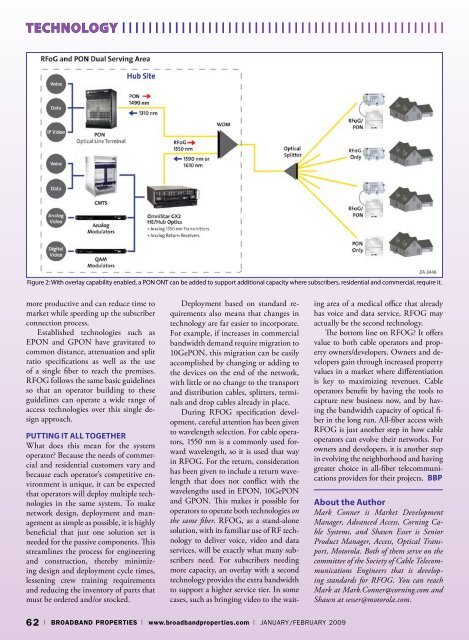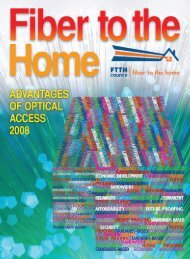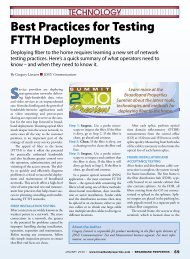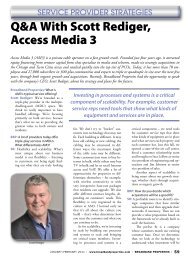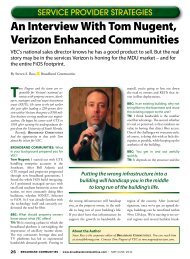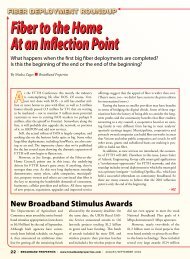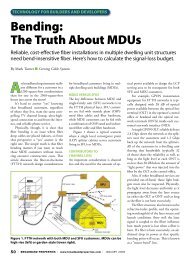bbpmag.com - Broadband Properties
bbpmag.com - Broadband Properties
bbpmag.com - Broadband Properties
Create successful ePaper yourself
Turn your PDF publications into a flip-book with our unique Google optimized e-Paper software.
TECHNOLOGY<br />
Figure 2: With overlay capability enabled, a PON ONT can be added to support additional capacity where subscribers, residential and <strong>com</strong>mercial, require it.<br />
more productive and can reduce time to<br />
market while speeding up the subscriber<br />
connection process.<br />
Established technologies such as<br />
EPON and GPON have gravitated to<br />
<strong>com</strong>mon distance, attenuation and split<br />
ratio specifications as well as the use<br />
of a single fiber to reach the premises.<br />
RFOG follows the same basic guidelines<br />
so that an operator building to these<br />
guidelines can operate a wide range of<br />
access technologies over this single design<br />
approach.<br />
Putting It All Together<br />
What does this mean for the system<br />
operator Because the needs of <strong>com</strong>mercial<br />
and residential customers vary and<br />
because each operator’s <strong>com</strong>petitive environment<br />
is unique, it can be expected<br />
that operators will deploy multiple technologies<br />
in the same system. To make<br />
network design, deployment and management<br />
as simple as possible, it is highly<br />
beneficial that just one solution set is<br />
needed for the passive <strong>com</strong>ponents. This<br />
streamlines the process for engineering<br />
and construction, thereby minimizing<br />
design and deployment cycle times,<br />
lessening crew training requirements<br />
and reducing the inventory of parts that<br />
must be ordered and/or stocked.<br />
Deployment based on standard requirements<br />
also means that changes in<br />
technology are far easier to incorporate.<br />
For example, if increases in <strong>com</strong>mercial<br />
bandwidth demand require migration to<br />
10GePON, this migration can be easily<br />
ac<strong>com</strong>plished by changing or adding to<br />
the devices on the end of the network,<br />
with little or no change to the transport<br />
and distribution cables, splitters, terminals<br />
and drop cables already in place.<br />
During RFOG specification development,<br />
careful attention has been given<br />
to wavelength selection. For cable operators,<br />
1550 nm is a <strong>com</strong>monly used forward<br />
wavelength, so it is used that way<br />
in RFOG. For the return, consideration<br />
has been given to include a return wavelength<br />
that does not conflict with the<br />
wavelengths used in EPON, 10GePON<br />
and GPON. This makes it possible for<br />
operators to operate both technologies on<br />
the same fiber. RFOG, as a stand-alone<br />
solution, with its familiar use of RF technology<br />
to deliver voice, video and data<br />
services, will be exactly what many subscribers<br />
need. For subscribers needing<br />
more capacity, an overlay with a second<br />
technology provides the extra bandwidth<br />
to support a higher service tier. In some<br />
cases, such as bringing video to the waiting<br />
area of a medical office that already<br />
has voice and data service, RFOG may<br />
actually be the second technology.<br />
The bottom line on RFOG It offers<br />
value to both cable operators and property<br />
owners/developers. Owners and developers<br />
gain through increased property<br />
values in a market where differentiation<br />
is key to maximizing revenues. Cable<br />
operators benefit by having the tools to<br />
capture new business now, and by having<br />
the bandwidth capacity of optical fiber<br />
in the long run. All-fiber access with<br />
RFOG is just another step in how cable<br />
operators can evolve their networks. For<br />
owners and developers, it is another step<br />
in evolving the neighborhood and having<br />
greater choice in all-fiber tele<strong>com</strong>munications<br />
providers for their projects. BBP<br />
About the Author<br />
Mark Conner is Market Development<br />
Manager, Advanced Access, Corning Cable<br />
Systems, and Shawn Esser is Senior<br />
Product Manager, Access, Optical Transport,<br />
Motorola. Both of them serve on the<br />
<strong>com</strong>mittee of the Society of Cable Tele<strong>com</strong>munications<br />
Engineers that is developing<br />
standards for RFOG. You can reach<br />
Mark at Mark.Conner@corning.<strong>com</strong> and<br />
Shawn at sesser@motorola.<strong>com</strong>.<br />
62 | BROADBAND PROPERTIES | www.broadbandproperties.<strong>com</strong> | January/February 2009


